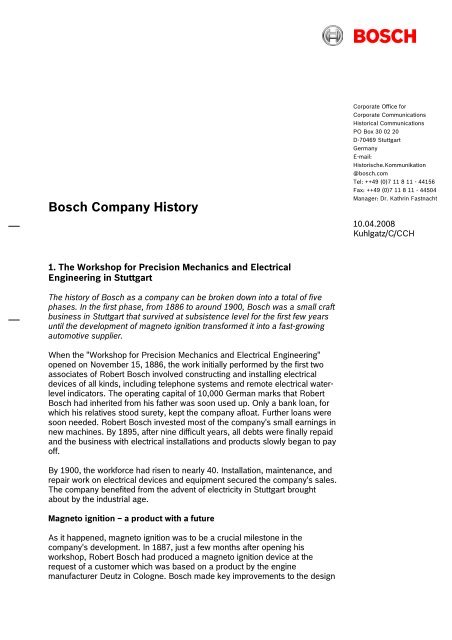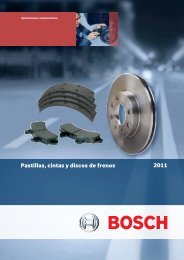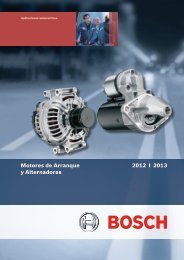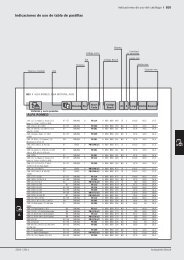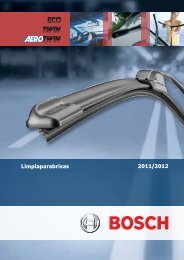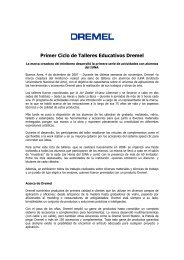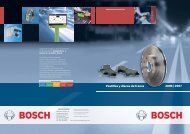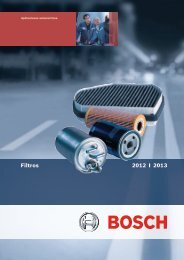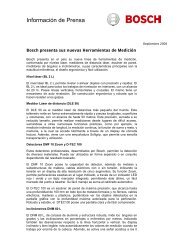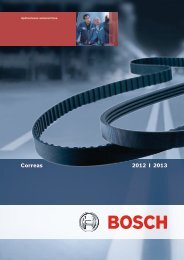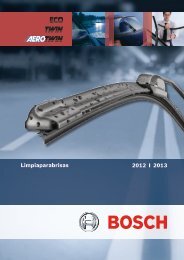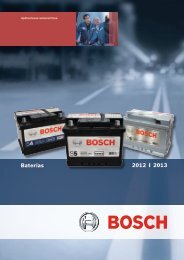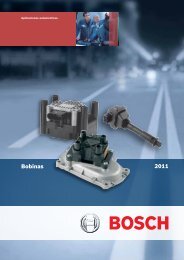Bosch Company History - Bosch Argentina
Bosch Company History - Bosch Argentina
Bosch Company History - Bosch Argentina
Create successful ePaper yourself
Turn your PDF publications into a flip-book with our unique Google optimized e-Paper software.
<strong>Bosch</strong> <strong>Company</strong> <strong>History</strong><br />
Corporate Office for<br />
Corporate Communications<br />
Historical Communications<br />
PO Box 30 02 20<br />
D-70469 Stuttgart<br />
Germany<br />
E-mail:<br />
Historische.Kommunikation<br />
@bosch.com<br />
Tel: ++49 (0)7 11 8 11 - 44156<br />
Fax: ++49 (0)7 11 8 11 - 44504<br />
Manager: Dr. Kathrin Fastnacht<br />
10.04.2008<br />
Kuhlgatz/C/CCH<br />
1. The Workshop for Precision Mechanics and Electrical<br />
Engineering in Stuttgart<br />
The history of <strong>Bosch</strong> as a company can be broken down into a total of five<br />
phases. In the first phase, from 1886 to around 1900, <strong>Bosch</strong> was a small craft<br />
business in Stuttgart that survived at subsistence level for the first few years<br />
until the development of magneto ignition transformed it into a fast-growing<br />
automotive supplier.<br />
When the "Workshop for Precision Mechanics and Electrical Engineering"<br />
opened on November 15, 1886, the work initially performed by the first two<br />
associates of Robert <strong>Bosch</strong> involved constructing and installing electrical<br />
devices of all kinds, including telephone systems and remote electrical waterlevel<br />
indicators. The operating capital of 10,000 German marks that Robert<br />
<strong>Bosch</strong> had inherited from his father was soon used up. Only a bank loan, for<br />
which his relatives stood surety, kept the company afloat. Further loans were<br />
soon needed. Robert <strong>Bosch</strong> invested most of the company's small earnings in<br />
new machines. By 1895, after nine difficult years, all debts were finally repaid<br />
and the business with electrical installations and products slowly began to pay<br />
off.<br />
By 1900, the workforce had risen to nearly 40. Installation, maintenance, and<br />
repair work on electrical devices and equipment secured the company's sales.<br />
The company benefited from the advent of electricity in Stuttgart brought<br />
about by the industrial age.<br />
Magneto ignition – a product with a future<br />
As it happened, magneto ignition was to be a crucial milestone in the<br />
company's development. In 1887, just a few months after opening his<br />
workshop, Robert <strong>Bosch</strong> had produced a magneto ignition device at the<br />
request of a customer which was based on a product by the engine<br />
manufacturer Deutz in Cologne. <strong>Bosch</strong> made key improvements to the design
of the magneto and achieved his first economic success with this product.<br />
The purpose of magneto ignition was to generate the electric spark needed to<br />
cause the air-fuel mixture in a stationary internal-combustion engine to<br />
explode. In 1897, <strong>Bosch</strong> was the first to apply a magneto ignition device to a<br />
vehicle engine. In so doing, he solved one of the key technical problems faced<br />
by the nascent field of automotive engineering and secured an encouraging<br />
number of orders from the automotive industry.<br />
27.03.2007<br />
Page 2 of 8<br />
By the end of the decade, <strong>Bosch</strong> had largely overcome his financial<br />
difficulties. The company's survival and growth were assured.<br />
2. <strong>Bosch</strong> becomes a global supplier of automotive equipment<br />
In the second phase of its history from around 1900 to 1925, the company<br />
moved solidly into the automotive technology sector. At the same time, it<br />
began to internationalize, with the founding of the first sales offices and<br />
manufacturing sites outside Germany. This period, however, was marked by a<br />
major disruption, with the loss of property and assets outside Germany after<br />
the First World War and the reconstruction of the company.<br />
As magneto ignition for automobiles underwent further development, the first<br />
orders came from the automotive industry in 1898. <strong>Bosch</strong> became an<br />
automotive supplier, and the company enjoyed undreamt-of growth thanks to<br />
the success of the automobile. From fewer than 40 associates in 1900, the<br />
workforce had risen to nearly 1,000 by 1907.<br />
Together with the company's British partner Frederick Simms, the first sales<br />
offices outside Germany were set up in England and France (1898 and 1899).<br />
Soon, <strong>Bosch</strong> was represented in nearly all European countries and, as from<br />
1906, on other continents as well. These included the U.S. and South Africa<br />
(1906), Australia (1907), <strong>Argentina</strong> (1908), China (1909), and Japan (1911).<br />
The first factory<br />
In 1901, Robert <strong>Bosch</strong> started up the company's first factory in Stuttgart with a<br />
workforce of 45. The acquisition of this new building, which was state-of-theart<br />
for its time, marked the company's transition from craft to industrial<br />
production. The second German factory was opened in nearby Feuerbach in<br />
1910. Productivity was impressive: by 1915, a total of two million magneto<br />
ignition systems had been manufactured.<br />
The company moved away from electrical installations to concentrate purely<br />
on automotive equipment. For a time, <strong>Bosch</strong> had a near-monopoly on the<br />
market for magneto ignition systems, with a world market share of over 90<br />
percent in 1913.<br />
Automotive equipment, war, and reconstruction<br />
Just before the First World War broke out, <strong>Bosch</strong> was represented on all key<br />
markets. With more than 88 percent of its sales being generated outside<br />
Germany, <strong>Bosch</strong> was already a global company in 1913. This was also the
year in which <strong>Bosch</strong> reached its second major automotive milestone: the<br />
market launch of the <strong>Bosch</strong> automotive lighting system. With a generator,<br />
battery, and headlights, this was the first complete system from <strong>Bosch</strong> and<br />
laid the foundation for today's automotive on-board electrical systems.<br />
27.03.2007<br />
Page 3 of 8<br />
During this phase of the company's development, Robert <strong>Bosch</strong> began to<br />
donate money to charitable causes, including all the profits from the<br />
company's First World War armaments contracts. During the early 1920’s,<br />
and despite the severe inflation in Germany in 1923 with its crippling effects<br />
on the economy, the company rapidly overcame the consequences of the war,<br />
in particular the loss of many of its sales offices and factories outside<br />
Germany. By 1925, the network of sales offices outside Germany was larger<br />
than it had been before the outbreak of the First World War.<br />
3. New products, modernization, drafting of today's corporate<br />
constitution<br />
In the third phase of the company's history from around 1925 to 1960, new<br />
business units were founded covering areas outside the field of automotive<br />
technology, and the corporate constitution was redrafted. During this phase,<br />
Robert <strong>Bosch</strong> withdrew from the operational side of the business. In his last<br />
will and testament dated 1937, five years before his death in 1942, he laid the<br />
groundwork for the corporate constitution that is still valid today. This period,<br />
however, was also overshadowed by National Socialism and the Second<br />
World War. After the end of the war in 1945, the company again had to rebuild<br />
production and trading networks outside Germany and the production facilities<br />
that had been destroyed in Germany itself.<br />
In the mid-1920's, Robert <strong>Bosch</strong> restructured the company's board of<br />
management. This move was prompted by the dramatic effects of the 1926<br />
crisis in the European automobile industry that caused the company's sales<br />
(from 1917 to 1937 incorporated as "Robert <strong>Bosch</strong> AG") to drop by around 35<br />
percent between 1925 and 1926. Robert <strong>Bosch</strong> appointed a new<br />
management team comprising Hans Walz, Karl Martell Wild, and Hermann<br />
Fellmeth. He himself retired from the management of the company at the age<br />
of 65.<br />
Crisis and new products<br />
The new management felt it necessary to make radical cutbacks in personnel<br />
at all levels. Between 1926 and 1927, jobs were cut by over 25 percent. The<br />
crisis was quickly brought under control – to some extent thanks to the<br />
rationalization measures recently introduced, in particular the productionboosting<br />
assembly-line system launched in 1925. The company also started<br />
to diversify. <strong>Bosch</strong> began to concentrate on other product segments in order<br />
to reduce its unilateral dependence on the automotive industry.<br />
New business units such as Power Tools, Junkers Gasgeräte (manufacturers<br />
of natural gas-fired water heaters), Blaupunkt (radios for the car and the<br />
household), Fernseh GmbH (television studio equipment), Kinobauer (cinema<br />
projectors), and Household Appliances soon put the company back on an<br />
even keel. Key milestones of the restructuring included the first power tool
(1928), the first series-produced car radio in Europe from Blaupunkt (1932),<br />
and the first <strong>Bosch</strong> refrigerator (1933).<br />
27.03.2007<br />
Page 4 of 8<br />
During this period, a new business unit was also created in automotive<br />
technology that had a lasting effect on strengthening this <strong>Bosch</strong> business<br />
sector. This new development was the diesel injection system for trucks<br />
(1927) that also became available for passenger cars from 1936 onwards and<br />
formed the technical basis for subsequent gasoline injection systems.<br />
Adaptation and opposition<br />
The years 1933 to 1945 saw the company having to adapt to National<br />
Socialist rule on the one hand while senior members of the company<br />
management became involved in resistance to the regime on the other. From<br />
the mid-1930’s onwards, <strong>Bosch</strong> succeeded in overcoming the last effects of<br />
the global economic crisis. To bolster the company’s resistance to possible<br />
outside influences, Robert <strong>Bosch</strong> restructured the company, changing it from<br />
an AG (public limited company) to a GmbH (private limited company) in 1937,<br />
five years before his death.<br />
When the war broke out and more and more skilled workers were called up to<br />
the front, <strong>Bosch</strong>, like other companies, used prisoners of war and forced labor.<br />
<strong>Bosch</strong> manufacturing sites became part of the armaments industry of the<br />
Third Reich, producing electrical components for military vehicles.<br />
Despite the economic upturn, the hostility of Robert <strong>Bosch</strong>'s successor in the<br />
company, Hans Walz, towards the National Socialists was manifest. Walz<br />
criticized the regime's economic policy and was particularly vehement in his<br />
opposition to state intervention. Only the company's importance as an<br />
armaments producer prevented Walz's imprisonment. A few months later, the<br />
<strong>Bosch</strong> CEO once again came under scrutiny by the authorities when<br />
investigations into the failed assassination attempt on Adolf Hitler on July 20,<br />
1944, uncovered a trail that led to the <strong>Bosch</strong> headquarters in Stuttgart. Walz<br />
was granted the title of “Righteous Among the Nations” by the Yad Vashem<br />
Holocaust Martyrs’ and Heroes’ Remembrance Authority in 1970 because,<br />
under his leadership, the company had protected associates of Jewish<br />
descent from deportation to concentration camps.<br />
New start after 1945<br />
Like many other German companies, <strong>Bosch</strong> was soon able to build on earlier<br />
successes after 1945. Although a considerable proportion of the Stuttgart and<br />
Feuerbach plants had been seriously damaged by air raids, the machines that<br />
were important for production had been moved to rural areas and as a result<br />
remained largely intact. From the summer of 1945 onwards, there were also<br />
already enough skilled workers available. The currency reform in 1948 was<br />
followed by rapid growth of the company. The workforce increased from just<br />
above 10,000 in 1948 to nearly 40,000 in 1958. Over the same period, sales<br />
rose from 85 million (1948) to 1,153 million German marks (1958),<br />
approximating a rise from 43 million to 580 million euros.<br />
However, this growth was at first threatened by the decartelization program of<br />
the victorious Allied forces. The feared breakup of the entire company and
loss of its subsidiaries was nonetheless averted, although <strong>Bosch</strong> had to make<br />
all its own patents and industrial designs available to competitors.<br />
27.03.2007<br />
Page 5 of 8<br />
Future-oriented technologies emerge<br />
Technologically, the company explored a number of different angles in the<br />
1950’s. It had to make up for a shortfall in innovations in a number of product<br />
areas. At the same time, however, developers were working flat out on new,<br />
pioneering technologies in other fields such as automotive electronics. Initial<br />
success in this field came in 1958 with the development of electronic<br />
components for the regulator unit of generators.<br />
Another important milestone was the mechanical gasoline injection system<br />
launched in 1951. This was followed by the rapid expansion of the power tools<br />
and household appliances product ranges, without doubt a result of the West<br />
German "economic miracle" that was starting to kick in at the time.<br />
As a consequence of the general economic upturn in the Federal Republic of<br />
Germany as the country moved towards full employment, an increasing labor<br />
deficit became apparent in the greater Stuttgart area in the mid-1950's. The<br />
company countered this by founding numerous plants in other regions of<br />
Germany between 1955 and 1965 (e.g. Nuremberg, Ansbach, Giengen, Bühl,<br />
and Blaichach).<br />
4. <strong>Bosch</strong> becomes a global technology group<br />
In the fourth phase of its history from around 1960 to 1990, <strong>Bosch</strong> began by<br />
introducing far-reaching reforms to its corporate structure and constitution.<br />
The end of this phase was marked by the fall of the Iron Curtain.<br />
As early as 1959, director of manufacturing Eugen Hagmaier presented a<br />
paper on the future development of the <strong>Bosch</strong> Group analyzing the company's<br />
situation from a manufacturing point of view in particular, and formulating<br />
appropriate consequences. The same year saw the start of work to restructure<br />
the company into divisions. The first was the Power Tools division, founded in<br />
1960.<br />
The work of Hans Walz, honorary chairman of Robert <strong>Bosch</strong> GmbH and<br />
chairman of the executors' committee, in drafting a new constitution for the<br />
company led in 1964 to a milestone in the company’s history. With the<br />
agreement of the heirs of Robert <strong>Bosch</strong> and in accordance with his will, the<br />
new corporate constitution was adopted and today's Robert <strong>Bosch</strong> Stiftung<br />
GmbH − a charitable foundation − was set up. Roughly 92 percent of the<br />
share capital of Robert <strong>Bosch</strong> GmbH is now held by this foundation. The<br />
<strong>Bosch</strong> family holds a strong seven percent of the share capital, while the<br />
remaining shares are held by Robert <strong>Bosch</strong> GmbH and Robert <strong>Bosch</strong><br />
Industrietreuhand KG, an industrial trust. The foundation transferred its voting<br />
rights in the shareholders' meetings of Robert <strong>Bosch</strong> GmbH to the trust.
Second and third waves of diversification<br />
A second wave of diversification also began in 1964. This included the<br />
Packaging Technology division, formed as a result of a series of acquisitions,<br />
and the pneumatics and hydraulics businesses − the beginnings of a later<br />
Automation Technology division.<br />
27.03.2007<br />
Page 6 of 8<br />
Much in the spirit of his predecessors Robert <strong>Bosch</strong> and Hans Walz, Hans L.<br />
Merkle, chairman of the board of management from 1963 to 1984, placed<br />
particular emphasis on strengthening international business. A crucial<br />
breakthrough was achieved in 1973 with the founding of the first <strong>Bosch</strong><br />
manufacturing site in the U.S. since the Second World War. <strong>Bosch</strong> was back<br />
on track to make the U.S. its strongest market outside Germany, as it had<br />
been before 1914.<br />
In a third wave of diversification, the company tapped into the<br />
telecommunications market with the step-by-step acquisition of Telenorma<br />
and ANT as from 1982. Under the leadership of Merkle's successor Marcus<br />
Bierich, chairman of the board of management from 1984 to 1993, the<br />
company expanded and pooled its telecommunications activities as from<br />
1987, though it was not until 1989 that these activities were ultimately<br />
integrated into a separate business sector – Communications Technology.<br />
This phase was also marked by a withdrawal from other areas of business.<br />
From 1986 onwards, after almost 60 years, <strong>Bosch</strong> gradually pulled out of the<br />
TV studio engineering sector, and in 1988 wound up its long-established<br />
projector and camera technology business, started when the company<br />
acquired Eugen Bauer GmbH in 1934.<br />
Automotive innovations<br />
The period between the divisionalization of the company from 1960 onwards<br />
and the end of the East-West divide saw <strong>Bosch</strong> develop some major product<br />
innovations, particularly in the field of automotive technology. These included<br />
the D-Jetronic electronically controlled gasoline injection system (1967), the<br />
ABS antilock braking system (1978), the EDC electronic diesel control (1986),<br />
the Blaupunkt TravelPilot navigation system (1989), and the ESP ® electronic<br />
stability program.<br />
At a time when discussion was starting to focus on road safety and<br />
environmental protection, these product innovations demonstrated <strong>Bosch</strong>'s<br />
commitment to low-emission, economical, and safe cars. <strong>Bosch</strong> summed up<br />
this commitment in the name of its "Safe, clean, economical" campaign<br />
launched in 1974.<br />
The growth of the company over these three decades can be clearly seen<br />
from the key data. Sales rose from around 2.2 billion German marks (around<br />
1.1 billion euros) in 1963 to almost 32 billion German marks (around 16 billion<br />
euros) in 1990. The share of sales generated outside Germany also increased<br />
in this period from 35 to over 50 percent, with the workforce growing from<br />
73,000 to over 180,000.
5. New challenges of globalization<br />
The fifth phase in the history of <strong>Bosch</strong> spans the period from 1990 to the<br />
present day. It includes the opening up of the eastern European markets, the<br />
rapid growth of Asian economies, and global networking of development,<br />
production, and sales.<br />
27.03.2007<br />
Page 7 of 8<br />
In 1993, Marcus Bierich handed over chairmanship of the board of<br />
management to Hermann Scholl. The Cold War was over and the states of<br />
the former Warsaw Pact were undergoing a process of democratization which<br />
for <strong>Bosch</strong> also meant new opportunities and new markets. At this point,<br />
however, the global economy was in the midst of a major recession. This<br />
recession was keenly felt by <strong>Bosch</strong> from the summer of 1992 onwards, and<br />
resulted in rationalization measures and job cuts at German locations<br />
between 1992 and 1994.<br />
Growing markets in eastern Europe and Asia<br />
At the same time, however, efforts were intensified to tap into foreign markets<br />
opening up in Asia and eastern Europe. The share of sales generated outside<br />
Germany, still 49 percent in 1993, increased to 72 percent by 2000.<br />
Alongside the conclusion of key joint ventures in China and Korea, <strong>Bosch</strong><br />
succeeded in pooling its activities in Japan thanks primarily to the acquisition<br />
of a majority share in Zexel Corporation from 1997 to 1999. In India too,<br />
where <strong>Bosch</strong> has been represented since 1919 and <strong>Bosch</strong> products have<br />
been manufactured under the brand name MICO since 1951, steps were<br />
introduced in 1997 to restructure the company's activities on this growth<br />
market with the founding of the regional company Robert <strong>Bosch</strong> India Ltd. A<br />
sales network and manufacturing sites were also set up in numerous markets<br />
in eastern and central Europe.<br />
New acquisitions and expansion<br />
The acquisition of AlliedSignal's brakes business in 1996 represented a key<br />
investment in the automotive technology sector. In 1999, a joint venture was<br />
founded with ZF Friedrichshafen for the production of steering systems for<br />
cars and commercial vehicles. However, the company's further development<br />
was also secured by divestments. Firstly, the automotive lighting activities of<br />
<strong>Bosch</strong> were integrated into a joint venture with Magneti Marelli called<br />
Automotive Lighting Holding, from which <strong>Bosch</strong> gradually withdrew. The<br />
second withdrawal took place in the Communications Technology business<br />
sector in 2000, with the sale of the Public Networks, Private Networks, and<br />
Terminals business units.<br />
The takeover of the hydraulics specialist Mannesmann Rexroth AG (2001)<br />
and the heating technology manufacturer Buderus (2003) had a major effect<br />
on the Consumer Goods and Building Technology and the Industrial<br />
Technology business sectors. These acquisitions not only reinforced <strong>Bosch</strong>'s<br />
market position in these sectors, but also helped counterbalance the<br />
predominance of automotive technology within the company's portfolio.<br />
Franz Fehrenbach, who took over the chair of the board of management from<br />
Hermann Scholl in 2003, is systematically continuing this policy. His
leadership is also characterized by a focus on the issues “renewable<br />
energies,” “energy efficiency,” and “emissions reduction.”<br />
27.03.2007<br />
Page 8 of 8<br />
At the end of 2000, <strong>Bosch</strong> had a workforce of more than 200,000 worldwide.<br />
By 2006, it had climbed to some 260,000. In 2004, sales topped the 40 billion<br />
euro mark. The share of sales generated outside Germany, still 49 percent in<br />
1993, amounted to 74 percent in 2006, a percentage only previously achieved<br />
by <strong>Bosch</strong> before the First World War.


